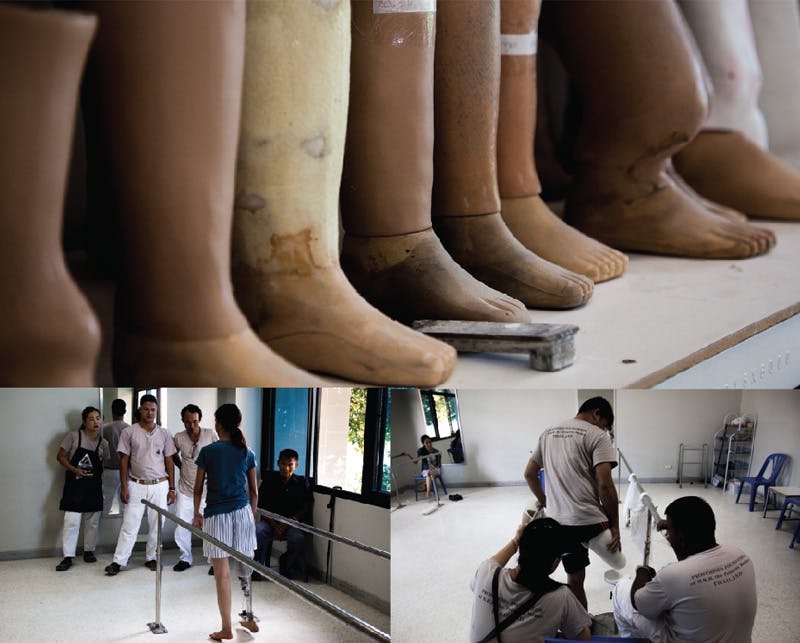When Therdchai “Chai” Jivacate graduated from medical school 50 years ago, he came to Chiang Mai to work in a hospital treating people with physical deformities. Most were poor farmers who had been injured on the land. Chai grew sick of having to amputate patients to save their lives, knowing that there was no chance of them receiving any kind of aftercare.
Today, Chai is secretary general of The Prostheses Foundation of Her Royal Highness the Princess Mother. If you’re an amputee, anywhere in the world, you can book a flight to Chiang Mai, arrive at the foundation without an appointment and by the end of the day you’ll leave with a tailor-made artificial leg. If for some reason your leg takes longer than expected, no need to book a hotel – they’ll put you up in private lodging on the grounds for the night. All free of charge.
Fifty years ago the foundation was just a vision in Chai‘s mind; in 1968 he travelled to Chicago to study rehabilitative medicine and prosthesis. Upon returning to Chiang Mai, he discovered that the cost of importing the necessary materials was far too high to help regular people. Undeterred, Chai devoted years to developing a system of creating artificial limbs out of recycled plastic, thereby drastically reducing the cost. Before, a new leg would have cost an amputee around 7,000 baht; now, through Chai’s method, it’s a mere 700. In 1992, the Prostheses Foundation was established and two years later Chai was granted an audience with HM King Bhumibol to demonstrate his process. While the King was impressed, he had one critique: a chemical element found in recycled bottles could cause skin irritation for the amputees. Accordingly, Chai was provided with the cleaner form of plastic he needed.
Today, none of the materials are recycled; however, costs are still incredibly low compared to the western world.

The technician’s workshop at the foundation is a huge warehouse buzzing with chatter, hammers and power tools. There are currently 14 permanent technicians who, in addition to producing an enormous volume of artificial legs, offer training to those wanting to become prosthesis technicians from other countries.
Training is usually coupled with the prosthesis foundation’s satellite programmes, whereby they establish similar workshops abroad. The list of locations is long and impressive: Burundi, Senegal, Burma, Bangladesh, Indonesia, Malaysia, Laos, Cambodia and Vietnam. Amputees who have made the journey to Chiang Mai to receive a leg come from countries as varied as Nepal, Bhutan, England, Germany and even Saudi Arabia.
Today at the foundation, which is located in Mae Rim, two Malaysian study technicians are hard at work over a pair of power sanders. Both are themselves amputees. As part of their training, they are producing legs for each other under the watchful gaze of their supervisor. Both lost their legs in automobile accidents and are hoping to start similar workshops on their return to Malaysia. As their leg sockets are tested, they joke about each other’s work. In the same room, a young woman trials her new prosthetic for the first time. This is her second leg; she looks a bit wobbly as she walks through the path with handles on either side. The technicians remove the leg and take it back to the workshop.
Despite the speed of their work, quality patient care is still the primary focus. Since the foundation was established, they’ve provided around 30,000 legs to around 20,000 amputees at a rate of approximately 3,000 legs a year in Thailand alone. For Chai, it’s all about efficiency, trying to help as many people as they possibly can. “For me, it’s always in my mind that I had to find a way to improve the service all the time because the amputees suffer,” he says. “We have to find the balance between helping as many people as possible and providing a quality prosthetic.
Without the leg they don’t have freedom, I need to help them have their freedom.” Indeed, amputation is common in Thailand where road accidents are frequent and the cheapest method of dealing with a damaged limb is simply cutting it off. “Before we arrive in some remote areas people try to help themselves in whatever way they can,” Chai says as he flicks through pictures of amputees who have created prosthetics out of bamboo, wine bottles and even one from Cambodia which is essentially a cannon shell grafted onto the leg below the thigh.
To address these remote people, the foundation has established a mobile clinic that drives around the border areas of Thailand. Floods of amputees turn up. Chai recalls a recent trip in which over 100 people arrived at a mobile clinic in Chiang Rai province on the Myanmar border. Five days later, everybody had a tailor-made prosthetic leg. “What about the carbon fibre running legs?” I ask. “Have you ever made those?” Chai chuckles. “I have no interest. They’re too expensive, too luxury. We try to help the people who really need it, who can’t help themselves. The farmer who needs to work in the field, walk in the rough, carry heavy loads. They’re the ones we want to find, they’re the ones who need the help.”
